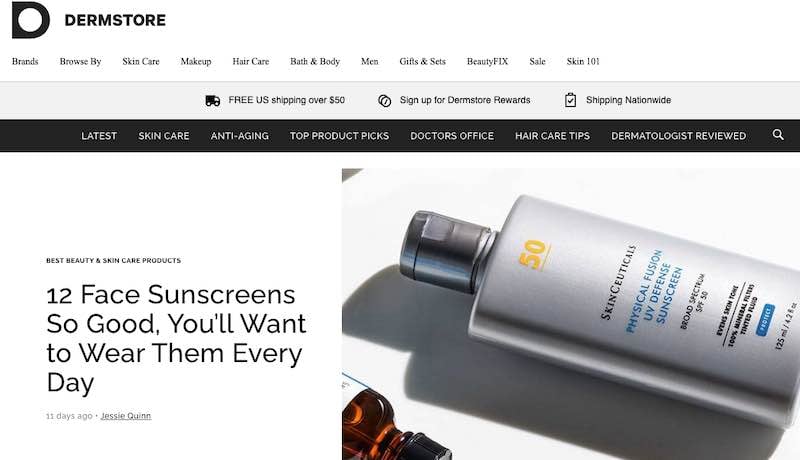Publishing a blog on an ecommerce site builds community, creates trust, and gives consumers a reason to return. Sales would likely follow.
But online merchants with long-term, quality blogs are rare. What follows are four of my favorites.
Mr Porter
Mr Porter is an online retailer of men’s fashion items, founded in 2011. The company sells roughly 300 designer brands. A companion site, Net-A-Porter, sells female fashion goods.
In 2014 Mr Porter launched “The Journal,” a weekly web magazine with a six-times-per-year print edition. In March 2020, the web version began posting daily, presumably due to its global popularity — The Journal claims 2.5 million monthly visitors.
The Journal’s posts are short and easy to absorb. The categories — Latest, Fashion, Grooming, Watches, Travel, Lifestyle — cover mostly fashion and accessories with additional topics to keep readers’ interest. All are related to Mr Porter’s products. For example, the products in the post “Every Polo Shirt You’ll Need This Summer” are on Mr Porter’s digital shelves. The items are linked in the body content.
Goop
Actress Gwyneth Paltrow founded Goop in 2008 as a weekly email newsletter providing health and wellness advice. She soon added a website followed by ecommerce. Article content remains Goop’s focus. The company now hosts a wellness summit, a celebrity cruise, a podcast, and a Netflix series.
Goop’s articles are accessible from the home page. Categories are Beauty, Food & Home, Style, Travel, and Wellness. Good PhD, a sixth category, is produced by the company’s science and research team to “compile the most significant studies and information on an array of health topics, conditions, and diseases.”

Goop’s articles are accessible from the home page. Categories are Beauty, Food & Home, Style, Travel, Wellness, and Good PhD.
Similar to The Journal from Mr Porter, Goop’s articles link to its products. For example, “6 Reasons to Make the Shift to Mineral Sunscreen” links to six products.
Goop’s newsletter summarizes the best blog posts as well as items for purchase.
Dermstore
Dermstore was founded in 1999 by a California-based dermatologist. It’s now a popular ecommerce site for skin care products, with over 350 brands. “The Dermstore Blog” addresses mostly skin care topics from experts. Categories are Skin Care, Anti-aging, Top Product Picks, Doctors Office, Hair Care Tips, and Dermatologist Reviewed. Dermstore’s content team consists of in-house and freelance writers, including physicians and licensed aestheticians.

“The Dermstore Blog” addresses skin care topics from experts. Categories are Skin Care, Anti-aging, Top Product Picks, Doctors Office, Hair Care Tips, and Dermatologist Reviewed.
Posts on The Dermstore Blog include “Buy Now” buttons and other links to the company’s products.
If your company can’t afford expert contributors, invite them to leave their opinion on a topic and then include it in a post as a quote. I once wrote for Dermstore and landed free expert interviews and quotes through the website Help a Reporter.
Motherly
Motherly started in 2015 as a blog focused on motherhood. The company has since added two podcasts, “The Motherly Podcast” and “Becoming Mama: A Pregnancy and Birth Podcast.” Motherly says its combined audience reaches 30 million users. The company raised $5.4 million in Series A funding in 2020 and then launched a store.
Motherly remains content-centric via in-house writers and submissions from mothers and practitioners such as pediatricians, nurses, and midwives. Categories are Pregnancy, Parenting, and Life. Posts include links to (paid) classes and store products, such as cribs, jogging strollers, and car seats.

Motherly started in 2015 as a blog focused on motherhood. In 2020 it launched a store. The site remains content-centric — categories are Pregnancy, Parenting, and Life.
CEO Jill Koziol said that Motherly’s brand is “woman-centered — not baby-centered — and expert-driven.” It then used that brand to sell products.
Building Trust
Trust is essential for building a sustainable brand. Content, done well, is an excellent way to build trust with customers and prospects. Each company above features expert authors on important topics multiple times per week. Consumers will enjoy reading the posts even if they don’t purchase a product.
But there’s nothing wrong with including product mentions, as the companies have demonstrated. The trick is to give away worthwhile information and include product mentions that support the topic.






